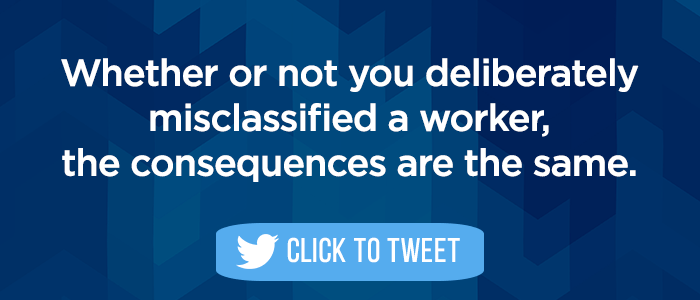[More often then not business owners make the huge but little known mistake of hiring employees with the intention of only having independent contractors. Read below to discover the 3 Signs You’ve Hired an Employee Instead of an Independent Contractor]
As more and more small businesses begin to emerge and affect the economic landscape, it opens the doors for those same business owners to begin delegating some of their “hats” to others.
This happens from outside help; better known as an Independent Contractor.
I get it.
You’re excited about your business growing.
Revenue is consistent, profits are showing up; and now you want to make sure you keep that momentum going.
Finally realizing you can’t do it all by yourself.
Yet, blowing your budget unnecessarily is not on your list of things to do.
So, you forge ahead identifying what you want to give up control over and outsource to the right person.
Or people that will maintain the integrity of the brand you’re building.
Next, you sit down and crunch the numbers to see if a regular employee will get the job done, or if you can you get the same quality work from an Independent Contractor?
To help you with that question, one of the first and most prevalent resources to pinpoint the best answer for you is…
The good ole government.
Who best to give you an insight on just how thin the line is?
Here’s how the IRS defines it
Workers are not necessarily employees, at least in a legal and tax sense.
If you hire people to perform functions for your company, the IRS could consider them as either employees or independent contractors.
The difference is critical – to you and to the IRS.
In general terms, employers do not have to pay payroll taxes and Social Security, provide benefits, pay unemployment or disability insurance, etc. for independent contractors.
If you require short-term or infrequent specialized skills, independent contractors can be the perfect solution.
But run afoul of IRS regulations and the penalties can be significant.
How do you determine if an individual is an employee or Independent Contractor?
The IRS focuses on three basic tests:
Behavior
Financial
Relationship
Let’s look at each.
Behavioral
As the employer, do you have direct control and the authority to control the ways and means the worker carries out work functions?
If so, the worker is most likely an employee rather than an independent contractor.
The key is the level of instruction you as the “employer” gives to the worker.
The more defined and complete those instructions, the more likely the worker should be classified as an employee.
Think of it this way…
If you hire an independent contractor, typically you explain the project and leave the details of how to carry out completing the project to the worker.
Do you provide training to the worker?
Employees are typically trained; independent contractors follow their own methods.
Keep in mind that even if you provide no instructions, if you have the right to control how the work is performed, the worker may still be an employee.
The critical point is whether you as an employer retain the right – even if you choose not to exercise that right – to control the ways and means a worker carries out essential job functions.
Financial
As an employer, do you have direct control over business aspects of the worker’s duties?
Do you control how the worker is paid?
Do you reimburse for expenses?
Do you provide tools, supplies, and other commodities?
If so, the worker is typically classified as an employee.
A few other factors to consider:
- Does the worker incur fixed costs for work currently performed? If so, the worker is an independent contractor.
- Has the worker made significant investment in the facilities or tools used to perform the work required? If yes, then the worker is classified as an independent contractor. (That may not be the case in certain industries, however; for example, automobile mechanics and construction workers are often required to furnish their own tools but are still classified as employees.)
- Does the worker provide services to other businesses? If so, the worker is almost always classified as an independent contractor, especially if they advertise those services and maintain a separate business location.
- Can the worker make a profit or suffer a loss on the work performed? If so, the worker is an independent contractor. Employees are simply paid; they do not enjoy profits or suffer losses.
Relationship
What is the legal relationship between you and the worker?
Do you have a written contract in place describing your business relationship?
Do you provide employee benefits like insurance, pension plans, vacation pay and sick pay?
If so, your relationship classifies the worker as an employee.
Another key test is permanency.
If the worker expects the relationship to only last for a specific project or defined period, the worker is typically classified as an independent contractor.
Keep in mind permanency can be overridden by other factors.
You may decide to engage an independent contractor in ongoing work that lasts for years – but if the worker meets other tests to qualify for independent contractor status, the duration of the relationship will not create an employer/employee relationship.
For example, if you hire a service person to maintain equipment at your facility, and that person performs that work for five years, if the Financial and Behavioral tests signify the worker is an independent contractor, the length of the business relationship is irrelevant.
The IRS uses the above tests to determine if a worker is an independent contractor or employee, even if other agreements are in place.
For example, if you have the worker sign an agreement stating he or she is an independent contractor and not an employee, it may not be sufficient to legally establish independent contractor status.
The IRS looks at the facts, not a written agreement, to determine the actual work relationship.
So, what happens if you classify a worker incorrectly?
The Impact of Misclassification
Whether or not you deliberately misclassified a worker, the consequences are the same.
Not only can you face penalties, you may be liable for damages like paying judgments for wages owed, back taxes, past medical expenses (if the worker was injured on the job), and other benefits not provided.
If you find yourself treating your IC more like an employer after reading the above, it would be a great idea to reassess and restructure your operations accordingly.
In summary, these are my best tips to determine Independent Contractors from Employees. As the CEO or business owner, it’s important that you keep your business compliant at all times.
Delmar Johnson is the Founder and Creator of HR Brain for Hire™ and has worked with Corporate environments, small businesses and micro-entrepreneurs for more than 20 years. For more innovative HR solutions visit www.hrbrainforhire.com or contact her directly at info@delmarjohnson.com.

















Clarity…Very helpful. Thanks